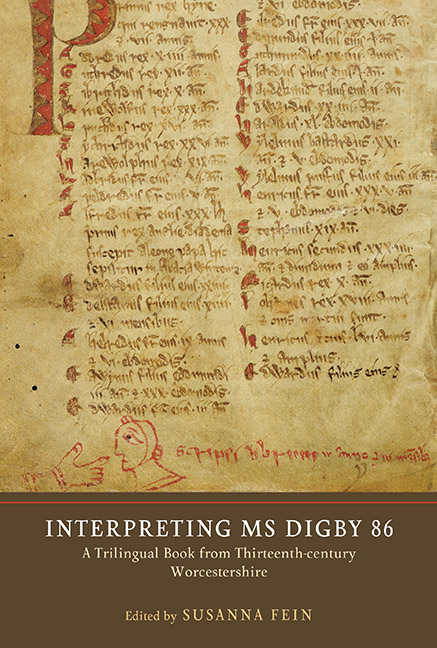Book contents
- Frontmatter
- Contents
- List of Illustrations
- List of Contributors
- Acknowledgements
- Abbreviations
- Digital Facsimiles of Frequently Cited Manuscripts
- The Contents of Oxford, Bodleian Library, Digby 86
- Note on the Presentation of MS Digby 86 Texts
- Introduction
- 1 Fellow Travellers with Saint Nicholas
- 2 Anglo-Norman Religious Instruction in MS Digby 86: Echoes of Lateran IV
- 3 Latin and Vernacular Prayers in MS Digby 86
- 4 Science, Medicine, Prognostication: MS Digby 86 as a Household Almanac
- 5 Literary Therapeutics: Experimental Knowledge in MS Digby 86
- 6 Petrus Alfonsi, the Disciplina clericalis and Le Romaunz Peres Aunfour of MS Digby 86
- 7 Misogyny in MS Digby
- 8 Gender Trouble? Fabliau and Debate in MS Digby 86
- 9 The Middle English Poetry of MS Digby 86
- 10 MS Digby 86 and Thirteenth-Century Scribal Poetics
- 11 The Scarlet Letter: Experimentation, Design and Copying Practice in the Coloured Capitals of MS Digby 86
- 12 Below Malvern: MS Digby 86, the Grimhills and the Underhills in their Regional and Social Context
- Bibliography
- Index of Manuscripts Cited
- General Index
- Manuscript Culture in the British Isles
11 - The Scarlet Letter: Experimentation, Design and Copying Practice in the Coloured Capitals of MS Digby 86
Published online by Cambridge University Press: 24 October 2019
- Frontmatter
- Contents
- List of Illustrations
- List of Contributors
- Acknowledgements
- Abbreviations
- Digital Facsimiles of Frequently Cited Manuscripts
- The Contents of Oxford, Bodleian Library, Digby 86
- Note on the Presentation of MS Digby 86 Texts
- Introduction
- 1 Fellow Travellers with Saint Nicholas
- 2 Anglo-Norman Religious Instruction in MS Digby 86: Echoes of Lateran IV
- 3 Latin and Vernacular Prayers in MS Digby 86
- 4 Science, Medicine, Prognostication: MS Digby 86 as a Household Almanac
- 5 Literary Therapeutics: Experimental Knowledge in MS Digby 86
- 6 Petrus Alfonsi, the Disciplina clericalis and Le Romaunz Peres Aunfour of MS Digby 86
- 7 Misogyny in MS Digby
- 8 Gender Trouble? Fabliau and Debate in MS Digby 86
- 9 The Middle English Poetry of MS Digby 86
- 10 MS Digby 86 and Thirteenth-Century Scribal Poetics
- 11 The Scarlet Letter: Experimentation, Design and Copying Practice in the Coloured Capitals of MS Digby 86
- 12 Below Malvern: MS Digby 86, the Grimhills and the Underhills in their Regional and Social Context
- Bibliography
- Index of Manuscripts Cited
- General Index
- Manuscript Culture in the British Isles
Summary
‘Ƨet morteus pecches sount. Li premer est orgod. Le secound est envie’. (fol. 1r)
ON the first opening of Oxford, BodL, MS Digby 86 as it is currently bound, the first coloured capital is backwards. The initial S is drawn in the same ink as the text, with red infill and a flourish in the top corner. It has been drawn back-tofront, with the upper curve starting in the top left and the spine running diagonally right to left. The apparent error on this folio prompts several questions. How did such a reversal happen? What decorative practices or design considerations caused it? And, as a corollary of this, what does such an elementary mistake suggest about the competency, training, skills or objectives of the scribe?
In attempting to answer these questions, it would be prudent first to confirm the identity of the person responsible for producing the initials and rubrication in Digby 86. Previous scholarship has suggested that the same person who decorated the manuscript was responsible for the majority of the writing – the scribe identified by Judith Tschann and Malcolm Parkes as Scribe A (termed here the ‘Digby scribe’). This ascription is probably correct; however, the evidence for it is rarely unpacked. In part, this evidence is material. The coloured capitals in Digby are usually filled in red or brown and sometimes a combination of the two. The same combination of red and brown inks is used in the marginal illustrations. By sight, it is possible to identify four different shades at various points in the manuscript: a pale brown, a dark brown, a watery orange-red and a thicker pink-red. In some sections, the colour of the line work and brown capitals appears to be the same as the ink used for the text. Similarly, the shade of red used for the capitals sometimes matches that used for titles and other rubrication. For example, the A that begins the Anglo- Norman verse Life of Saint Nicholas seems to have been drawn in the same ink as the text's title (‘Les miracles de seint nicholas’; fol. 150r), while initials several folios later seem to match the colour used to highlight the litterae notabiliores (fol. 152r). Palaeographic analysis suggests that the handwriting of these rubricated elements is the same leftward-sloping, late thirteenth-century anglicana of the main scribe.
- Type
- Chapter
- Information
- Interpreting MS Digby 86A Trilingual Book from Thirteenth-Century Worcestershire, pp. 219 - 254Publisher: Boydell & BrewerPrint publication year: 2019



